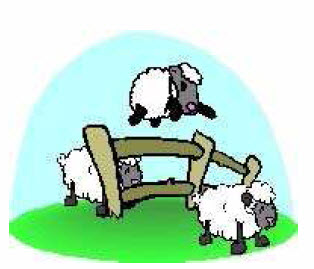ACM HDU-2952 Counting Sheep
Counting Sheep
Time Limit: 2000/1000 MS (Java/Others) Memory Limit: 32768/32768 K (Java/Others) Total Submission(s): 2060 Accepted Submission(s): 1359
Problem Description
A while ago I had trouble sleeping. I used to lie awake, staring at the ceiling, for hours and hours. Then one day my grandmother suggested I tried counting sheep after I'd gone to bed. As always when my grandmother suggests things, I decided to try it out. The only problem was, there were no sheep around to be counted when I went to bed.![]()
Now, I've got a new problem. Though counting these sheep actually helps me fall asleep, I find that it is extremely boring. To solve this, I've decided I need another computer program that does the counting for me. Then I'll be able to just start both these programs before I go to bed, and I'll sleep tight until the morning without any disturbances. I need you to write this program for me.

Now, I've got a new problem. Though counting these sheep actually helps me fall asleep, I find that it is extremely boring. To solve this, I've decided I need another computer program that does the counting for me. Then I'll be able to just start both these programs before I go to bed, and I'll sleep tight until the morning without any disturbances. I need you to write this program for me.
Input
The first line of input contains a single number T, the number of test cases to follow.
Each test case begins with a line containing two numbers, H and W, the height and width of the sheep grid. Then follows H lines, each containing W characters (either # or .), describing that part of the grid.
Each test case begins with a line containing two numbers, H and W, the height and width of the sheep grid. Then follows H lines, each containing W characters (either # or .), describing that part of the grid.
Output
For each test case, output a line containing a single number, the amount of sheep flock son that grid according to the rules stated in the problem description.
Notes and Constraints 0 < T <= 100 0 < H,W <= 100
Notes and Constraints 0 < T <= 100 0 < H,W <= 100
Sample Input
2
4 4
#.#.
.#.#
#.##
.#.#
3 5
###.#
..#..
#.###
Sample Output
6
3
值得注意的是:bfs()函数里面定义的参数一定要定义成全局变量,如果用C语言的scanf来输入数据,要用getchar()来清除缓存区的'\n'。

1 #include<iostream> 2 using namespace std; 3 4 int arr[4][2]={0,1,1,0,0,-1,-1,0}; //分四个方向搜索 5 char sheep[101][101]; 6 int T,i,j,sum,h,w; 7 8 //搜索羊群 9 void bfs(int a,int b) 10 { 11 if(sheep[a][b]=='.') return; //遇到 '.'返回 12 if(a<0||b<0||a>=h||b>=w) return; //数组越界返回 13 sheep[a][b]='.'; //记录,将每次找到的羊群变成'.',下次循环直接跳过 14 for(int i=0;i<4;i++) 15 bfs(a+arr[i][0],b+arr[i][1]); //找到每只羊以后向四个方向搜索 16 } 17 18 int main() 19 { 20 cin>>T; 21 while(T--) 22 { 23 cin>>h>>w; 24 for(i=0;i<h;i++) 25 for(j=0;j<w;j++) 26 cin>>sheep[i][j]; //此处利用c++的输入方法,不用考虑缓冲区换行符的影响 27 sum=0; 28 for(i=0;i<h;i++) 29 for(j=0;j<w;j++) 30 { 31 if(sheep[i][j]=='#') 32 { 33 ++sum; //用sum来记录每次找到的羊群数量 34 bfs(i,j); 35 } 36 } 37 cout<<sum<<endl; 38 } 39 return 0; 40 }




 浙公网安备 33010602011771号
浙公网安备 33010602011771号